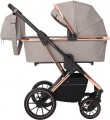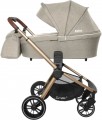Foldable carrycot
Pushchairs in which the carrycot has a foldable design. This feature simplifies the storage and transportation of the stroller, when folded, the
foldable carrycot takes up much less space.
Carrycot carry handle
The carrycot carry handle for carrying is mounted on the carrycot and makes it easy to carry it from place to place — for example, if you need to remove the carrycot for cleaning and then put it back. The handle can have a different shape — in the form of an arc attached to the sides of the carrycot, in the form of a hood cutout, etc.
Viewing window
A window made of transparent or translucent material, built into the hood that covers the cradle or seating unit. In the version with a walking block,
the viewing window is usually located so that the parent can see the baby directly while moving, without being distracted from controlling the stroller. In cradles, the parent can see the child through a window by approaching the stroller from the side of the hood (that is, on the opposite side of the handle); implementations with a window in the front hemisphere of the hood are less common. In addition, a baby lying in a cradle can usually see the outside world through the window (primarily the sky above the stroller). The viewing window can be made in the form of oilcloth or a mesh mosquito net, through the holes of which air freely penetrates, but insects and small debris raised by the wind are retained.
Depreciation
The depreciation theme is designed to absorb shocks and bumps from uneven road surfaces. The most popular nowadays are models with
spring systems; you can also meet the shock absorption of the
articulated and
double types, and in quite a large number of pushchairs this function is absent at all. Here are the main features of each option:
— Spring type. Depreciation systems based on classical springs mounted on individual wheels. They are used in all types of pushchairs except classic pushchairs (see "Design"). The simplest models use a single set of springs, while more advanced models may include additional comfort features such as SAS shock/vibration absorption technology. Whatever the case, depreciation systems of this type are simple yet practical, efficient and reliable.
— Articulated type. The type of depreciation used in pushchairs with carrycots - classic, universal, transformers. The frame, on which the carrycot or seat unit is installed, in such models is attached to the base of the pushchair with the help of special bridges, which play the role of depreciation. As bridges can be used belt hinges, such systems can also refer to the articulated. Anyway, this type of depreciation is excellent for carrycots. First of all, the pushchair is as smooth and soft as possible, which contributes to the comfort and deep sleep of the child (and the parent to
...drive the pushchair is much easier, especially on uneven surfaces). Secondly, the carrycot on such a pushchair can be rocked back and forth, lulling the baby. On the other hand, such systems are poorly suited for pushchair frames with swivel front wheels; and the failure of one absorber leads to tilting of the carrycot.
— Double. This term most often refers to the spring systems described above with additional shock absorbers on the frame of the pushchair. Such systems help to maximize vibration reduction and can approach articulated systems in terms of efficiency (see above). On the other hand, the softness of the suspension can be inconvenient when overcoming curbs and other bumps: to raise the front wheels of the pushchair, you have to press hard on the handle.
— Is absent. Pushchairs without depreciation are not suitable for uneven surfaces: in such conditions, the pushchair will be shaken violently, which creates both discomfort for the baby and inconvenience for the parent. On the other hand, such models have advantages over pushchairs with depreciation. First, due to the lack of unnecessary parts, they are much cheaper, and the design itself is as simple as possible and at the same time reliable. Secondly, without depreciation, it is easier to overcome curbs and other obstacles: to raise the front wheels, it is enough to push a small pressure on the handle. Thirdly, such pushchairs rock less on smooth, wave-like uneven surfaces.Handle height adjustment
Possibility
to adjust the stroller handle in height. This function allows you to optimally adjust the length of the handle to the height of the parent. It will be especially useful if the parents are of different heights, and each of them regularly carries a stroller.
Typically, height adjustment is carried out by lowering or raising the upper segment of the handle, and in advanced implementations
a telescopic mechanism is responsible for it. The retractable handle makes the stroller more adaptable to different situations and conditions. For example, it can be lengthened for more comfortable walking or shortened for ease of use in tight spaces.
Frame material
The main material from which the frame of the pushchair is made.
— Aluminium. The material used in the vast majority of modern pushchairs of all price categories. This is due to a number of advantages: aluminium is light and at the same time durable, it does not rust and is not afraid of moisture, it lasts a long time, it looks nice, but it is relatively inexpensive — somewhat more expensive than steel, but noticeably cheaper than more advanced materials like carbon.
— Steel. Steel frames are as strong as aluminium frames, and they are much cheaper. On the other hand, they are quite heavy, so steel is used less often in pushchairs.
— Magnesium alloy. Premium Material: Stronger and more durable than aluminium, just as lightweight, but at a significantly higher cost. It is extremely rare, in single models of expensive pushchairs.
— Carbon. Another high-end material: carbon fiber filled with plastic. This combination gives excellent strength - comparable to steel — at a very low weight. However, carbon is very expensive, and these advantages are rarely decisive for pushchairs — in most cases simpler materials are enough. That is why carbon frames have not become widespread.
— Plastic. Plastic itself is easy to manufacture and relatively cheap; it is also not as cold to the hands in cool weather as aluminium or steel. However, modern pushchairs very rarely have frames made of this material. The fact is that low-cost vari...eties of plastic are not strong enough for this; and high-quality varieties cost accordingly - their price is close to aluminium, or even higher.
— Fibreglass. In this context, "fibreglass" typically refers to glass fibers mixed with plastic filler. Unlike conventional window glass, glass fibers are flexible and strong. The plastic filler enhances durability by offering scratch and tear resistance. The result is a material that is lightweight and very strong. However, fibreglass is prone to brittleness, especially with point impacts, and is susceptible to abrasion. As a result, it isn't widely used in pushchairs.
Rear wheels without axle
Pushchairs in which the rear wheels are mounted on completely separate stands, without any additional bridge between them.
The main advantage
of rear wheels without an axle is that the legs of the parent following the stroller do not touch the bridge between the wheels. In addition, this feature slightly increases the mobility (allows the stroller to pass between the wheels lying on the road objects, without clinging to them with the axle).
Wheels
The type of wheels installed on the pushchair.
The most popular in our time are
rubber wheels, including
air-filled ones.
Plastic wheels are used mainly in inexpensive pushchairs to further reduce the cost, while
gel ones, on the contrary, are considered a very advanced option.
Polyurethane wheels and
EVA foam-filled wheels are also widely used. Here is a more detailed description of each of these varieties:
— Rubber. Rubber solid tires, found in many modern pushchairs, are popular due to their affordability, quiet operation, and smooth ride over bumps. While less effective on uneven surfaces compared to air-filled and gel wheels, solid rubber tires are cost-effective, low-maintenance, damage-resistant, and suitable for various wheel diameters, including small ones.
— Air-filled. Air-filled rubber tires, commonly featured on pushchairs, offer a softer ride and facilitate easy maneuvering on uneven surfaces and high curbs. Despite their higher cost, they require periodic maintenance to ensure proper pressure and protection against cuts or punctures. However, users find air-filled wheels manageable, as they are thick and less prone to damage.
— Plastic. Plastic wheels, commonly featuring both tire and rim made from this material (thou
...gh some have metal rims), are known for their simplicity and affordability. However, they lack durability, reliability, and effective vibration dampening due to their hardness. Typically found in low-cost pushchairs with small wheels designed for flat surfaces.
— Gel. Wheels similar in design to air-filled tires (see the relevant paragraph), but filled not with air, but with a special gel. The main advantage of this option is its insensitivity to small punctures and cuts: coming out, the gel in the tire in contact with air almost instantly solidifies, effectively sealing the damage. In addition, such wheels are virtually maintenance-free — they do not need to be inflated. The disadvantages of gel tires include high cost and somewhat higher rigidity than air-filled tires (although in terms of softness of running such wheels are still noticeably superior to rubber and even more so to plastic ones).
— Polyurethane. Solid polyurethane tires offer excellent maneuverability, shock absorption, puncture resistance, and durability. They are unaffected by extreme temperature changes and are cost-effective, making them a common choice for various pushchair types.
— EVA. Wheels made of microporous foam rubber, specifically EVA material, offer high elasticity, excellent cushioning, and wear resistance. Lightweight and puncture-resistant, these wheels provide a smooth pushchair ride. However, they may stiffen in cold winter weather.Front wheels diameter
The diameter of the front wheels installed in the stroller.
At the same time, the front wheels are not as important for mobility as the rear wheels: for example, to overcome obstacles, the stroller is often lifted "on its toes" by tilting it towards itself, with only the rear wheels working. Therefore, the diameter of the front wheels may be noticeably smaller than the rear wheels. It should be noted here that the small size also has its advantages — the wheels are lighter.
Speaking of specific numbers, diameter
up to 15 cm is considered very modest,
16 — 20 cm — small,
21 — 25 cm — medium,
26 — 30 cm is larger than average and
more than 30 cm is large.

